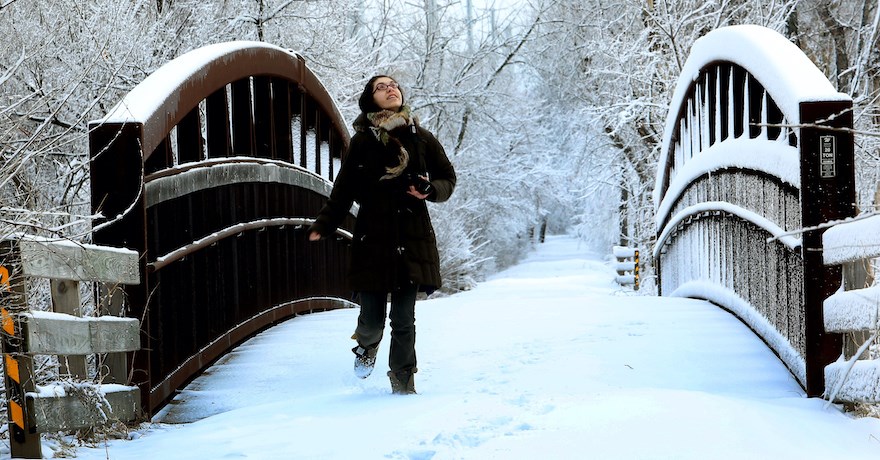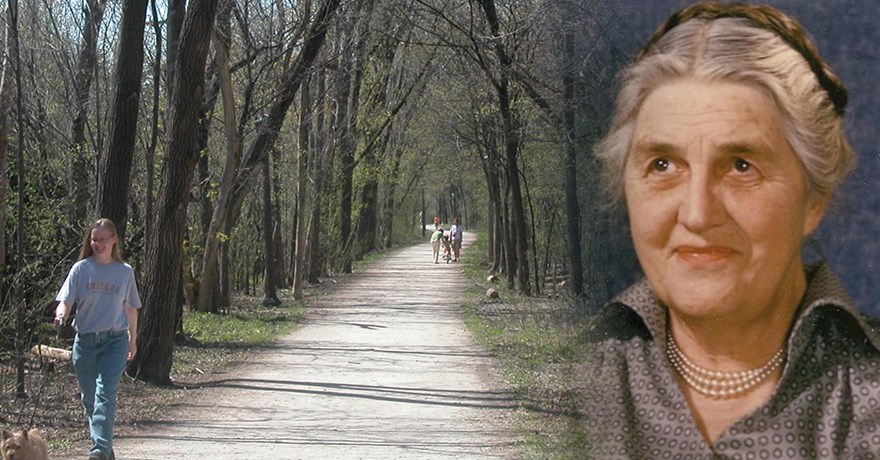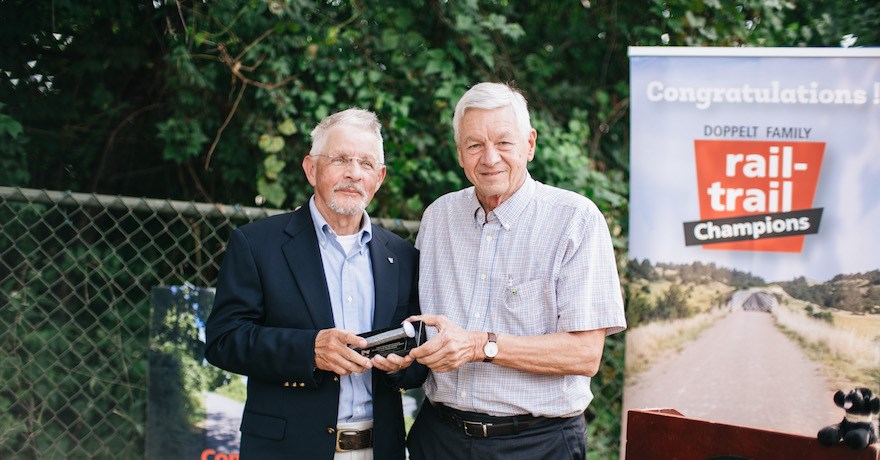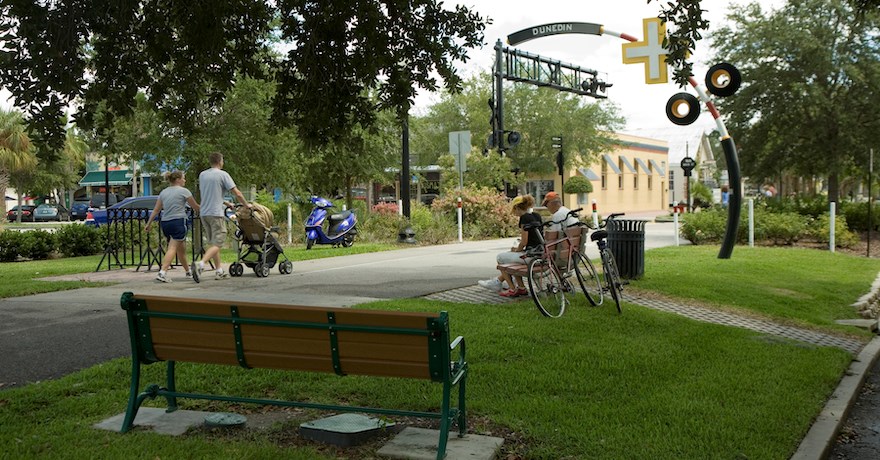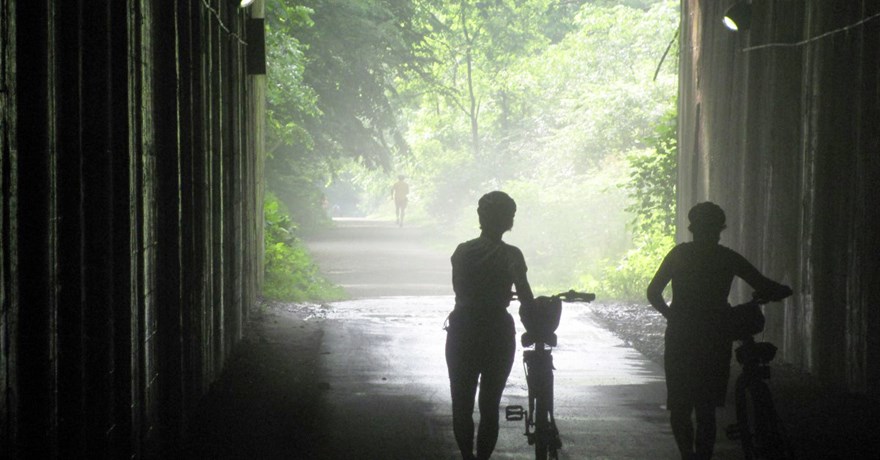History of RTC and the Trails Movement
David Burwell and Peter Harnik, Rails to Trails Conservancy co-founders | Photo by Robert Trippet
Timeline | History of RTC | History of Movement | Railbanking
History Timeline
Check out our interactive timeline below to browse important moments in the history of RTC and trail development in America.
History Of Us
Thirty years ago, a group of people came together with an idea. That idea turned into a spark that would activate a movement. Meeting together regularly in our nation’s capital, this collection of conservation and parks groups, walking and biking enthusiasts, railroad history buffs and active-transportation advocates quickly realized the need for a dedicated organization to help preserve the nation’s disused railroad corridors by transforming them into trails … and in February of 1986, Rails to Trails Conservancy opened its doors.
Since our founding, RTC has worked from coast to coast, supporting the development of thousands of miles of rail-trails and multiuse trails for millions of people to explore and enjoy. Our work combines national policy advocacy and research expertise with on-the-ground trail development. We advocate for trail-friendly policies and funding at the federal and state levels—in the courts, in Congress and throughout the country. Through our trail development work, we have helped thousands of communities in America plan, build and maintain trails in urban, suburban and rural places.
RELATED: 30 Years, Birth and Evolution of Rails to Trails Conservancy
“In 1965…Rails-to-Trails was still a highly localized movement; people said, ‘We’ve got an abandoned railroad track, so let’s use it.’ Only gradually did there emerge a realization that America desperately needs a national trails system, and that unused rail corridors are the perfect backbone for that network.”
—Peter Harnik, RTC Co-founder
History of Our Movement
Check out RTC Co-Founder Peter Harnik’s book, “From Rails to Trails: The Making of America’s Active Transportation Record,” the fascinating tale of the rails-to-trails movement as well as a consideration of what the continued creation of rail-trails means for the future of America.
The origins of the rail-trail movement stem from the late 1890s, and found a spark in the mid-1960s in the Midwest that would ignite a nationwide phenomenon.
The idea: To convert the abandoned or unused rail corridors—which were closing at an increasingly rapid pace across America—into multiuse trails.
As tracks started being pulled out, people instinctively began walking and bicycling along the old corridors, socializing, exploring, enjoying nature, discovering railroad relics and marveling at the bridges and tunnels. These early users started calling them “rails-to-trails”—a name that quickly caught on. Of course, none of the corridors were paved; that came later.
The rail-trail movement saw its formal birth with the creation of the Illinois Prairie Path and Wisconsin’s Elroy-Sparta State Trail in the 1960s.
Origins of Railbanking—and Its Impact
In 1980, Congress passed the Staggers Rail Act, which largely deregulated America’s struggling railroad industry and allowed for the discontinuation of unprofitable routes. This prompted the abandonment of 4,000 to 8,000 miles of lines each year throughout the early 1980s. In 1983, Congress became concerned about the potential permanent loss of thousands of miles of rail corridor and amended the National Trails Systems Act to create “railbanking,” a tool to preserve inactive corridors for future rail use, while providing for interim trail use.
Peter Raynor, the 2018 Doppelt Family Rail-Trail Champion, explains what railbanking is. Raynor was the central author of the 1983 Railbanking Act, which has led to the creation of more than 4,400 miles of rail-trails across the country.
The primary benefits of rail-trails were considered initially to be corridor preservation, recreation, and protection of open space, and trails often were built with limited public funds dedicated to parks and recreation. This focus shifted significantly with the passage of the federal Intermodal Surface Transportation Efficiency Act of 1991, or ISTEA, which was championed by RTC. For the first time, federal surface transportation funds were available for trails, walking and biking through the creation of the Transportation Enhancements and Recreational Trails Programs.
Since that time, RTC has fought to protect federal funding for trails, walking and bicycling, and has also helped grow and expand the sphere to new and innovative programs focusing on safety, climate and connectivity—culminating recently with the $1.2 trillion Bipartisan Infrastructure Law in 2021, dedicating unprecedented funding to trails active transportation infrastructure.
When we opened our doors, there were less than 1,000 miles of open rail-trails in America. Today, there are more than 26,000 miles of rail-trails providing safe, joyful, vibrant spaces for millions of people to walk, bike and connect to the outdoors.
With RTC’s nearly four decades of leadership in the movement—in collaboration with thousands of partners—the “great idea” has blossomed into a nationwide effort to connect trails and walking and bicycling routes across the country. We’ve come to recognize and champion the transformative potential of connected walking and bicycling systems on communities and entire regions—as safe places to get where we need to go, as recreation and tourism destinations, and as places for physical activity and simply connecting to nature.
Trail networks are making a lasting, impactful mark on thousands of communities, with nearly 26,000 miles of rail-trails providing safe, joyful, vibrant spaces for millions of people to walk, bike and connect to nature.
Our role as defender, protector and supporter of trail development persists, and we have taken on a leadership role to accelerate the pace of trail network development in America.
